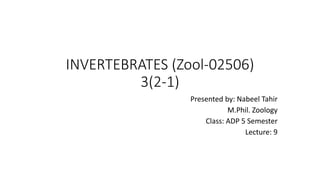
INVERTEBRATES ASCHELMINTHS.pdf
- 1. INVERTEBRATES (Zool-02506) 3(2-1) Presented by: Nabeel Tahir M.Phil. Zoology Class: ADP 5 Semester Lecture: 9
- 3. Aschelminths (Gr. askos, bladder +helmins, worm) 1. The aschelminths comprise seven phyla: Rotifera Kinorhyncha Nematoda, Nematomorpha, Acanthocephala, Loricifera Priapulida 2. The major unifying aschelminth features: • Pseudocoelom: The pseudocoelom is a type of body cavity that develops from the blastocoel (the primitive cavity in the embryo) and is not fully lined by mesoderm, as in the true coelomates. • In the pseudocoelomates, the muscles and other structures of the body wall and internal organs are in direct contact with fluid in the pseudocoelom. • Digestive tract • a muscular pharynx • constant cell numbers (eutely) • Protonephridia • a cuticle • adhesive glands.
- 4. EVOLUTIONARY PERSPECTIVE • Two phylogeny hypotheses: 1. The first hypothesis contends that the phyla are related based on the presence of the following structures: a pseudocoelom, a cuticle, a muscular pharynx, and adhesive glands. 2. The second hypothesis contends that the various aschelminth phyla are not related to each other; thus, they are probably polyphyletic. • The similarities among the living aschelminths may simply be the result of convergent evolution as these various animals adapted to similar environments. • Common ancestor might have been a primitive, ciliated, acoelomate turbellarian.
- 5. GENERAL CHARACTERISTICS • Distinct body cavity. • Lack mesentary, organs lie free • Pseudocoelom fluid-filled or contain a gelantinous substance • Most have complete tubular digestive tract from mouth to anus which allows for mechanical breakdown of food, digestion, absorption and feces formation • Most are microscopic (some grow to over a meter) • Bilaterally symmetrical • Unsegmented • Triploblastic • Cylindrical in cross section • Most are dioecious (reproductive organs are in separate animals)
- 6. Cont.…... • Cuticle present: may bear spines or scales and is useful for protection and taxonomic identification • Molting or ecdysis shed their cuticle. • Eutely – Same number of cells for each animal and for each given organ • Ex. Caenorhabditis elegans (a type of nematode) has 959 cells • Every worm has 80 cells in their pharynx. • Protonephridia. • Cephalization
- 7. PHYLUM ROTIFERA (L. rota, wheel +fera, to bear) • Corona (Gr. krowe, crown),– ciliated organ around the head used for locomotion and food gathering. • 0.1 to 3 mm in length. • Most are freshwater (less than 10% marine). • wheel animalicules ? • Triploblastic, bilateral, unsegmented, pseudocoelomate • Complete digestive system, regionally specialized • Anterior end often has a ciliated organ called a corona • Posterior end with toes and adhesive glands • Well-developed cuticle • Protonephridia with flame cells • Males generally reduced in number or absent; parthenogenesis common
- 8. EXTERNAL FEATURES • Epidermally secreted cuticle used for protection • Lorica – thickened cuticle that makes an encasement used for protection and support • Epidermis is syncytial. • Head has a mouth, brain, sensory organs. • Foot has 1-2 toes. • Foot has pedal glands.
- 9. Body parts Head (Anterior) • Corona • Mouth • Buccal field Trunk • Middle Foot • Toes • Adhesive glands
- 10. PHYLUM KINORHYNCHA (Gr. kinein, motion + rhynchos, snout) • Less than 1 mm long. • Elongate, bilaterally symmetrical. • Exclusive to marine environments. • No external cilia or locomotor appendages. • Burrow in mud & sand with snouts. • 150 species. • Dioecious. • Feed on diatom & algae and organic matter.
- 11. EXTERNAL FEATURES Body surface: • Lack cilia • Composed of 13 or 14 definite units called zonites. • zonite 1: The head: Bears the mouth, an oral cone, and spines. • zonite 2: The neck: Contains spines called scalids and plates called placids. The head can be retracted into the neck. • Remaining 11 or 12 zonites: The trunk: Bears a pair of lateral spines and one dorsal spine in each trunk zonite. Terminates with the anus. Body wall: • Consists of a cuticle • Epidermis • Two pairs of muscles: dorsolateral and ventrolateral. • Pseudocoelom is large and contains amoeboid cells.
- 12. PHYLUM NEMATODA (Gr. nematos, thread) • Triploblastic, bilateral, vermiform (resembling a worm in shape; long and slender), unsegmented, pseudocoelomate. • Body round in cross section and covered by a layered cuticle; molting usually accompanies growth in juveniles. • Complete digestive tract; mouth usually surrounded by lips bearing sense organs. • Most with unique excretory system comprised of one or two renette cells or a set of collecting tubules. • Body wall has only longitudinal muscles.
- 13. EXTERNAL FEATURES • Slender, elongate, cylindrical, and tapered at both ends. • Outer, noncellular, collagenous cuticle. • Cuticle may be smooth, or contain spines, bristles, papillae (small, nipplelike projections), warts, or ridges. • Three primary layers of cuticle: o cortex, o matrix layer o basal layer. • Cuticle Functions: o Internal hydrostatic pressure o Provides mechanical protection, and o Resists digestion by the host. The cuticle is usually molted four times during maturation.
- 14. Cont.…… • Epidermis or hypodermis: Beneath the cuticle, surrounds the pseudocoelom. • May be syncytial. • Longitudinal muscles: Cause locomotion. • Contraction of these muscles results in undulatory waves that pass from the anterior to posterior end of the animal, creating thrashing movements. • lack circular muscles. • Some have lips, some have spines or teeth on those lips • Sensory organs: Amphids – chemoreceptors along the cuticle Phasmids - chemoreceptors near the anus Ocelli – eyespots found in aquatic nematodes
- 15. PHYLUM NEMATOMORPHA • Horse hair worm / Gordian worm • Bilaterally symmetrical, and vermiform. • They are present on body hair of horse • Body wall has thick cuticle,cellular epidermis,logitudnal cards amd muscle layer of logitudnal fiber . • Sexes are separate • When eggs mature they leave the body and enter into the water, then growth/Completion of eggs occur in water, and enter in another organisms through water. • Next species generate through eggs in water • Has no circulatory system (no blood system)